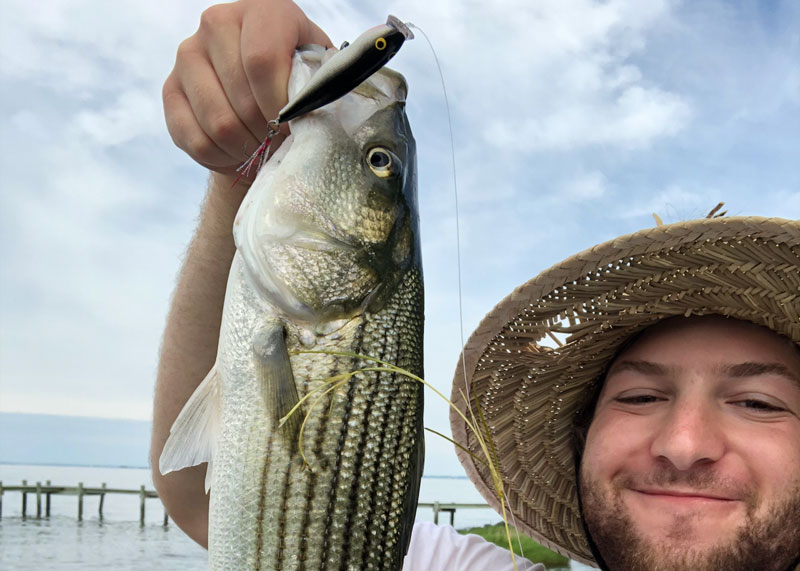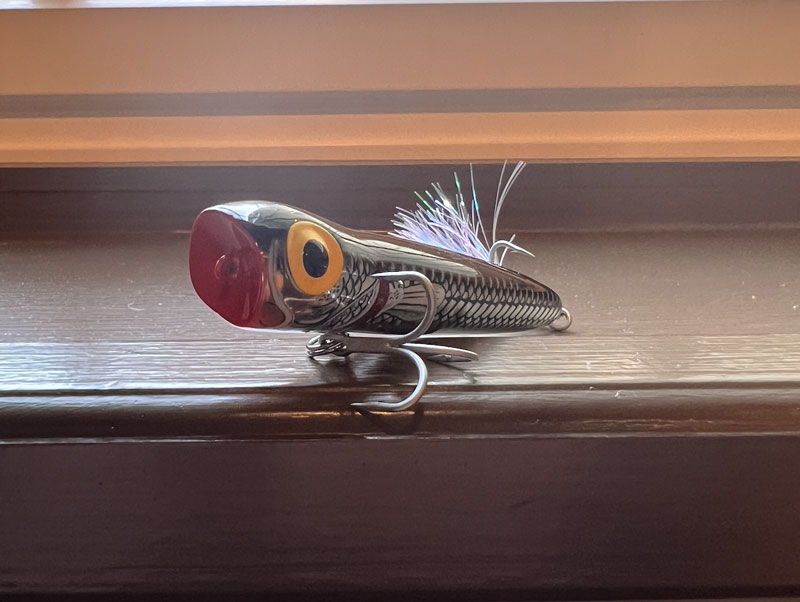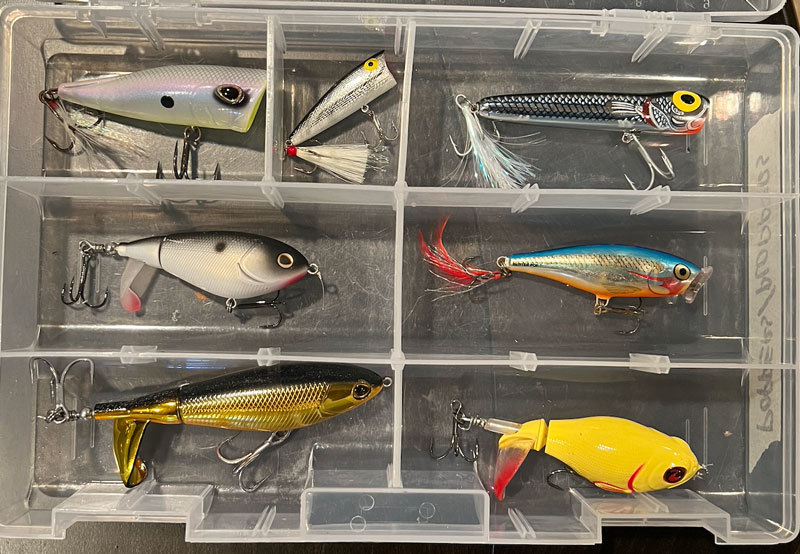The absolute adrenaline rush and unforgettable battle that follow an explosive topwater strike are moments that every novice angler should have the privilege of experiencing. Let’s dive into the chaos and excitement of fishing surface lures.

Topwater fishing is the art of throwing floating lures that get worked across the surface of the water to imitate injured or fleeing prey, triggering exhilarating bites that are amazing to watch, result in drag-pulling fights, and will have you tying on a topwater every chance you get.
Surface lures come in all manner of sizes because most (not all) predatory species can be caught on them. Whether you’re targeting panfish like perch and bluegill, popular game fish such as black bass and rockfish, or even giant tuna and mahi, we as anglers are blessed with topwater options galore.
Types of Topwater Lures and How to Fish Them
There are loads of different topwater lures, but for the sake of simplicity, we’ll just focus on the three most popular. The first and arguably most well known is the popper. This lure is typically shaped like a cylinder that tapers down at either the back, middle, or front, depending on the style. Its shining feature is the concave mouth, which spits water during the retrieve, causing lots of commotion and drawing the attention of fish lurking nearby.
To use a popper, make a long cast and wait a second or two when it hits the water. Sometimes, the initial splash is enough to draw a strike. No bite right off the bat? Begin working the lure by twitching the rod tip and then reeling up the slack. Make sure that each time you twitch, the popper throws water, or “pops.” If your lure isn’t popping, jerk the rod tip a bit harder next time. Make sure to pause every so often, as this may convince a fish following your offering to commit to an easy meal. As far as retrieval speed and cadence, the fish will decide that, not you. Today, they might want a pop, pop, pause. Tomorrow, it’s a pop, pause, pop-pop-pop, pause that gets them biting. Play around and experiment until the fish show you what they want.

Our second and easiest-to-fish topwater lure is the plopper. These lures are similar in shape (and name) to a popper but can often be more bulky and rounded. Instead of a cupped face, ploppers are equipped with a propeller, usually at the rear, that sputters and creates a wake when retrieved.
Simply cast out your plopper and reel it back in, making sure to crank just fast enough to get the propeller spinning. If you aren’t getting bites at that speed, then try it a bit quicker– sometimes fish want the thrill of a chase.
Finally, we have the spook. Shaped like a cigar and often equipped with an internal rattle, this lure is meant to be fished with a “walk-the-dog” retrieve that imitates a fleeing baitfish. Working a spook properly takes a bit of practice, but if you’ve mastered the popper and plopper and are looking for a challenge, this is a fun one to try.
After making a long cast with your spook, point your rod tip down and begin twitching your wrist in a rhythmic motion. Reel in the slack as you work the rod tip, and the lure should dart side to side in a zig-zag, or “walk-the-dog” motion. Maintaining a steady cadence is key in keeping your spook walking smoothly. Remember to pause on occasion to convince a chasing fish to commit. Same as with our other two topwater offerings, vary your retrieval speed from cast to cast until you find what turns on the bite.

When and Where to Fish With Topwater Lures
If you’re like me and quickly become addicted to the wonderful chaos that is topwater fishing, it’s likely you’ll want to reach for a surface lure before tying on anything else. But, you must show restraint. If you throw these lures in the wrong conditions, you greatly minimize your chance of a strike and may end up so frustrated that you throw in the topwater towel before ever experiencing a blowup.
Low-light conditions are key for topwater fishing. Predatory fish have a greater advantage when they are less visible to their prey, allowing them to more easily ambush a meal. Furthermore, as is especially the case during the summer months, fish seek deeper, cooler water when the sun gets high in the sky. And, the further the fish are from the surface, the less likely they are to swim all the way up and go after a topwater lure. Look to throw poppers, ploppers, and spooks at dawn, at dusk, and on overcast days if you want the best chance of catching fish on top.
In the Chesapeake Bay region, most of our species will begin hitting topwater in the spring and continue through autumn. During the colder months of the year, however, using topwater lures is not ideal. On a cold, blustery December Saturday, many of us find ourselves sitting by the fire with no intention of going outside. Well, fish are the same way when it’s chilly out. They seek warmth and comfort, which is often down in the depths, far away from the surface. In addition, a fish’s metabolism slows way down in the winter, making him less eager to go after prey that requires a frantic chase.
As far as location is concerned, look for any type of structure with current flowing near it. This includes hard structure like rocks or wood, vegetation such as grass or lily pads, and man-made features like piers, duck blinds, or jetties. Fish want a place to hide so that they have the element of surprise when ambushing prey, so throwing topwater around structure is a good bet.
Finally, stick to the shallows. Here, no matter where the fish is in the water column it’s still close enough to the surface to notice the commotion of your topwater lure. Of course, if you’re out in deep water and see fish breaking on the surface, don’t hesitate to tie on a topwater lure. For the most part, however, shallower water will produce more bites on top.
If you’re fishing during the aforementioned prime hours for topwater, then you’ll begin to notice that schools of baitfish are often up shallow during dawn and dusk – a telltale sign that you should probably cast close to shore.
Try Topwater Fishing!
Every beginner fisherman should feel like they have the opportunity to catch fish on topwater. No more watching surface blowups on the internet, wishing you were “good” enough to experience them for yourself. Well, take it from a longtime fisherman who was once in your shoes – you are good enough. Topwater fishing takes patience and the right conditions, but after the first time you see a fish blast out of the water to eat your lure, you’ll be hooked for life.
- By Adam Greenberg
Note: Many conservation-minded anglers in the Chesapeake Bay region are making the switch from treble hooks to single hooks on their surface plugs. We all love targeting striped bass, especially on topwater, but fishing with trebles increases the chance of fish mortality. Single hooks are less likely to cause severe damage to the fish, as there are less points that can penetrate skin, eye, gill, or any other part of the body. They are also often easier and quicker to remove, resulting in less time out of the water for the fish. Most topwater lures come standard with trebles attached via split rings. Grab yourself a pair of split ring pliers, some replacement single hooks, and do your part in supporting the health of the striped bass and other fisheries in the Chesapeake Bay.